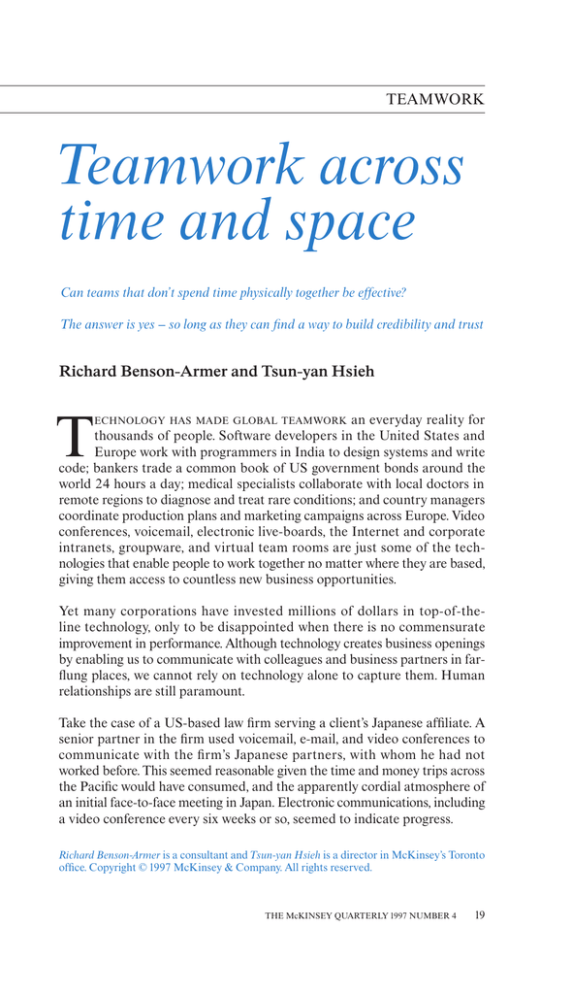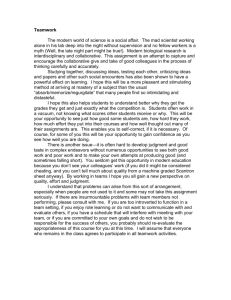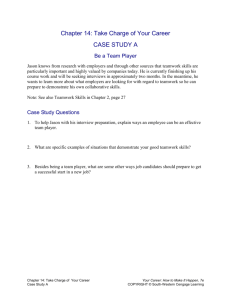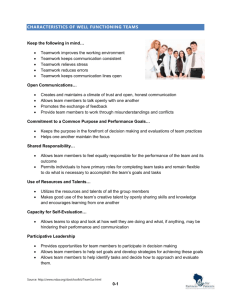
TEAMWORK
Teamwork across
time and space
Can teams that don’t spend time physically together be eƒfective?
The answer is yes – so long as they can find a way to build credibility and trust
Richard Benson-Armer and Tsun-yan Hsieh
ECHNOLOGY HAS MADE GLOBAL TEAMWORK an everyday reality for
thousands of people. Soƒtware developers in the United States and
Europe work with programmers in India to design systems and write
code; bankers trade a common book of US government bonds around the
world 24 hours a day; medical specialists collaborate with local doctors in
remote regions to diagnose and treat rare conditions; and country managers
coordinate production plans and marketing campaigns across Europe. Video
conferences, voicemail, electronic live-boards, the Internet and corporate
intranets, groupware, and virtual team rooms are just some of the technologies that enable people to work together no matter where they are based,
giving them access to countless new business opportunities.
T
Yet many corporations have invested millions of dollars in top-of-theline technology, only to be disappointed when there is no commensurate
improvement in performance. Although technology creates business openings
by enabling us to communicate with colleagues and business partners in farflung places, we cannot rely on technology alone to capture them. Human
relationships are still paramount.
Take the case of a US-based law firm serving a client’s Japanese aƒfiliate. A
senior partner in the firm used voicemail, e-mail, and video conferences to
communicate with the firm’s Japanese partners, with whom he had not
worked before. This seemed reasonable given the time and money trips across
the Pacific would have consumed, and the apparently cordial atmosphere of
an initial face-to-face meeting in Japan. Electronic communications, including
a video conference every six weeks or so, seemed to indicate progress.
Richard Benson-Armer is a consultant and Tsun-yan Hsieh is a director in McKinsey’s Toronto
oƒfice. Copyright © 1997 McKinsey & Company. All rights reserved.
THE McKINSEY QUARTERLY 1997 NUMBER 4
19
TEAMWORK ACROSS TIME AND SPACE
But the US lawyer began to grow suspicious when requests for intermediate
reports were acknowledged, but not fulfilled. Distracted by other client
demands, he did not follow up, expecting his Japanese colleagues to deliver as
agreed. But four months into the project, the client’s CEO called to complain
about shoddy work – a situation the US lawyer felt would never have arisen
had he known the other team members, or had everyone been working in
the same place.
On reflection, the lawyer realized he had been wrong to assume that other
team members shared his objectives and standards. It had not occurred to
him that serving the client’s aƒfiliate might not be a priority for his Japanese
partners, or that their purpose might diƒfer. To make matters worse, he had
failed to define suƒficiently specific performance goals for monitoring the
team’s progress. In the end, he had to fly in a team from the United States to
redo a large part of the work, at huge expense to the firm.
Horror stories like this abound. The ease with which people can contact one
another in today’s business world makes them forget how diƒficult it is to
work well as a team. But eƒfective teamwork is hard to pull oƒf at the best of
times, and if team members come from diƒferent cultures, speak diƒferent
languages, and seldom have the luxury of face-to-face meetings in which to
size up their colleagues, it can prove a nightmare.
Teamwork depends in great measure on members’ ability to trust one
another, and technology can be no substitute for the relationships that
engender such trust. Successful global teams therefore pay great attention
to building the foundations of sound teamwork. But they also work hard to
compensate for some of the human elements that are inevitably lost when
teams work together, yet apart.
Real diƒferences
Working in teams that span the globe poses problems not usually encountered when a group of people work together in the same building. Some are
obvious. If members of global teams work in diƒferent time zones, then
responses to queries or requests for information needed to get on with a task
will be delayed. And if team members in Shanghai or Singapore are 12 hours
ahead of those in New York or Toronto, they will have no opportunity to call
one another during normal business hours.
Many companies use time diƒferences to their advantage by transacting
business around the clock. Teams of bond traders can trade their book of
US government issues in London, then New York, followed by Tokyo or
Singapore, before returning to London the next morning. For some people,
however, time diƒferences can be frustrating. Certain multinationals regularly
20
THE McKINSEY QUARTERLY 1997 NUMBER 4
TEAMWORK ACROSS TIME AND SPACE
require all overseas aƒfiliates to participate in meetings that are scheduled
in the headquarters’ time zone. Thus, a 2 p.m. conference call with New York
means that location managers in Australia and Singapore are sitting around
in their pyjamas until the early hours waiting to take part. Such insensitivity
is unlikely to build team spirit.
Other problems are more insidious. It is said that non-verbal communication – a twitching face muscle, a furtive glance, a reddening neck betraying
rising stress – can account for as much as 60 percent of the message an
individual conveys. But team members in separate locations are deprived
of these clues to their colleagues’ opinions, attitudes, and emotions. Even
video conferencing, the best tool currently available to teams that cannot
meet face to face, has limitations. Facial expressions can be hard to pick
up if transmission is poor, and much can be
happening oƒf camera or when the “mute”
Working in teams that span the
button is pressed.
globe poses problems not usually
encountered when people work
together in the same building
Moreover, team members oƒten do not know
the people with whom they are assigned to
work. When all participants are in the same
location, team-building dinners and outings can act as invaluable icebreakers
at the start of team assignments. But when social contact is replaced by
e-mail or video conferences, team members lose the chance to socialize with
colleagues, form opinions of them, and bond.
Cultural diƒference is another stumbling block. It is one thing to expect sophisticated, well-traveled investment bankers from diƒferent countries to work
smoothly together in an international institution in a cosmopolitan city. It is
a far taller order to expect, say, a Newfoundland mining manager to work
with a politically appointed Chinese mining manager in remote Shanxi
province, using Toronto-based lawyers and Hong Kong accountants to pull
oƒf a successful joint venture. The technology that brings them together on a
single project will do nothing to narrow the cultural chasm between them.
Another diƒficulty is that although technology increases the geographic
scope for teamwork, it also widens the potential for conflict as it cuts across
corporate fiefdoms, with each team member trying to balance the demands
and priorities of power bases at home with those of the team. To complicate
things further, technology makes it possible for individuals to participate in
many more teams than they could if they had to attend frequent meetings
or regularly fly long distances.
A German risk specialist, grudgingly loaned to a corporate taskforce assessing investment opportunities in the Czech Republic, had to work every weekend for a month to fulfill all his commitments. His superiors in Frankfurt did
THE McKINSEY QUARTERLY 1997 NUMBER 4
21
TEAMWORK ACROSS TIME AND SPACE
not believe the project would produce any new insights for German investors.
They therefore maintained his usual local workload, while assuring him that
“a few hours on the phone” was all head oƒfice required. The vice-president
leading the taskforce assumed that all the team members assigned to the
chairman’s project regarded it as their top
priority, and demanded a detailed report
Can teams that don’t spend
within six weeks. The risk specialist was
time physically together
caught in the middle.
ever be as eƒfective
as those that do?
The challenge of managing heavy and sometimes competing demands is not unique to
those who operate in global teams, of course. But it can be harder for them to
resolve. Team leaders are likely to find it more diƒficult to marshal support
from colleagues dotted around the globe, who are understandably caught up
in their own local problems. As a result, teamwork may never materialize,
and expectations may go unmet.
Same magic
Teams that perform well recognize that there are essential disciplines that
must be established no matter where they work. In their book The Wisdom
of Teams,* Jon R. Katzenbach and Douglas K. Smith identify four such
“team basics.”
The first three basics can be attained whether or not team members work in
the same place. To begin with, a team must have complementary skills that
together will be equal to the task in hand. Second, it must establish goals
and individual and collective accountability for achieving them. Third, it
must agree a common approach to getting work done.
A common sales approach for a global engineering products company, for
example, might involve a protocol setting out which of its sales oƒfices will
call on a customer’s head oƒfice and foreign subsidiaries, how technical
enquiries should be processed, and the roles of individual functions in
assembling and pricing bids. Without a common approach, confusion reigns
and nothing can be accomplished.
If a team works apart, however, it will need far more discipline to achieve
these three basics. Before the team starts work, the team leader or coordinator will need to facilitate a discussion that nails down roles, goals, and
accountabilities. When there are no face-to-face meetings, such discussions
can too oƒten go by the board. Regular follow-up conference calls can be
used as a substitute for the informal discussions that give co-located team
≠ Harvard Business School Press, Boston, Mass., 1992.
22
THE McKINSEY QUARTERLY 1997 NUMBER 4
TEAMWORK ACROSS TIME AND SPACE
members a sense of making progress toward goals. Similarly, all members
need to be clear about what work must be done between calls.
The fourth basic, a common purpose, is a lot harder to achieve and, unlike
the others, not easy to quantify. A common purpose is what binds team
members to the task in hand. Unlike business objectives, which tend to be
industry- or product-specific (credit ratings in the investment bank’s case, for
example), common purpose must harness individuals’ pride and seize their
imagination as something worth eƒfort and sacrifice. It is oƒten arrived at
only aƒter team members have struggled through debate and reflection –
but along the way, trust deepens, members start to feel connected to one
another, and energy is released that catapults the team to remarkable levels
of performance. This is an intensely personal process, however, and it thrives
on face-to-face meetings.
So if the performance stakes are high enough, the cost of holding such
meetings before work begins is clearly justified.
At the start of its 777 project, Boeing brought members of the design team
from a dozen countries to Everett, Washington, giving them the opportunity
to work together for up to 18 months. From a practical point of view, they
learned how to function eƒfectively within the company’s project management system. But shared experiences also engendered a level of trust
between individuals that later enabled them to overcome the obstacles raised
by their separation.
The eƒfectiveness of Boeing’s huge globally scattered team eƒfort has been
widely documented. With members from more than a dozen countries linked
by a network of 1,700 workstations, the team designed and launched the 777
in five years – at least 30 to 40 percent faster than a comparable paper-based
design. The plane also boasted 33 percent greater fuel eƒficiency than a 747,
and cost 25 percent less.
Lotus, developer of Notes groupware, also brings together its employees to
“develop some level of trust and relationship before moving into electronic
communication,” as Chris Newell, executive director of the company’s R&D
arm, put it. Eastman Kodak does likewise. According to John Spencer,
worldwide manager for the design and development of the company’s singleuse camera, gathering teams together physically helps friendships to form,
work styles to merge, and – again – trust to develop.
In many situations, however, it is impractical to bring a team together for
any meaningful period. The travel time and costs, not to mention wear and
tear on the body, rule it out. The question then is: can teams that don’t spend
time physically together ever be as eƒfective as those that do?
THE McKINSEY QUARTERLY 1997 NUMBER 4
23
TEAMWORK ACROSS TIME AND SPACE
Diƒferent magic
The short answer is “no” – in theory, at least. Remote teams do not go through
the intense personal interaction needed to shape a common purpose. There
again, teams that do get together don’t necessarily establish a common
purpose. In practice, only about 5 percent of teams reach a level of performance that goes beyond the sum of what individuals could achieve on their
own. It is perfectly possible, therefore, for remote teams to be among the best
performers provided they pay attention to the first three team basics, then
find ways to compensate for the loss of physical togetherness. There are three
options they can pursue:
Shape shared beliefs
Geographically dispersed team members oƒten operate within vastly diƒferent
contexts. Their beliefs are shaped by the world around them, and these beliefs
in turn govern their behavior. Financial market fundamentals in Tokyo are not
the same as those in New York, for example, which means that a New York
bond trader could have a diƒferent view of what the latest US trade deficit figures
might mean for bond prices than a trader in Japan. In such a case, it would be
vital for team members to discuss the likely size of the deficit before the figures
are announced, and to agree in advance how each trader should react.
One multinational paper company negotiating a joint venture in China
discovered how problematic a lack of shared beliefs can be. Team members
at head oƒfice disagreed with those in China about whether fiber was likely
to be in short supply, and if it was, whether it should be secured through
plantation ownership or locked-in supply contracts. Opinions also diƒfered
over whether the new venture should generate its own power on site or buy
from the provincial power grid. Head oƒfice thought power prices likely to
escalate, while the team on the ground felt
reassured by a letter from the municipal
Credibility and trust cannot
government that guaranteed stable prices.
help but be in short supply
when team members are unable
to get to know one another
The team’s inability to agree delayed the
already lengthy process of gaining approval
from the ministry of electric power to build
an on-site power plant, which head oƒfice thought was the best course of
action. Every time the power issue was raised, the discussion degenerated
into a personal argument. Tempers flared as team members’ judgment and
motives were questioned. And as discussions got bogged down, tension
escalated to the point where the whole venture was in jeopardy.
The paper company’s experience demonstrates how important it is that team
members’ collaboration be underpinned by shared beliefs. When remote
teams invest time to make sure that they think the same way about essentials,
other problems are likely to be less damaging.
24
THE McKINSEY QUARTERLY 1997 NUMBER 4
TEAMWORK ACROSS TIME AND SPACE
A useful technique for remote teams is to pose and discuss a dozen or so
fundamental questions. Examples might be: how quickly will our industry
grow in the next five years? Who will be the most formidable competitors? Is
our goal (a doubling of new product launches, say) feasible? What are our
top three priorities? By examining areas of potential conflict and taking the
time to resolve diƒferences, remote teams can build a reserve of goodwill that
will cushion them against the inevitable diƒficulties that dispersal brings.
Build a storehouse of credibility and trust
Credibility and trust cannot help but be in short supply when team members
are unable to get to know one another. A lack of trust can create diƒficulties
if time delays make it impossible to check for consensus before decisions are
taken, say, or members who miss a team meeting are unsure that their
colleagues will represent their interests and do the right thing on their behalf.
Developing shared beliefs partly compensates for the deficit, but there are
plenty of other areas where trust is required, yet may be lacking.
A professional judgment made by an individual team member separated by
time and space from colleagues must oƒten be taken on trust by those
colleagues. So must a decision made on the basis of confidential information.
In these circumstances, colleagues can judge the individual only by his or
her reputation. For this reason, team members should pay careful attention to
the way others perceive them. They should deliver on their promises, and do
so on time; consider other people’s schedules; deal straightforwardly with
colleagues; and respond promptly to e-mails and voicemails, even if they do
not know the sender.
It isn’t always possible to avoid having your actions distorted or even misrepresented by others. But if you have been a reliable team player in the past,
your reputation will counter these and other hiccups such as transmission
losses, delayed responses, and the second-guessing that can be rampant
among team members working in diƒferent locations.
Team members should also reach out to help others. This might involve extra
eƒfort – be it to respond to a request or to pass on to others ideas that might
benefit them – and it seldom brings immediate reward or recognition. But
the long-term benefits in terms of building a reputation and accruing trust are
immeasurable. A good deed might even lead to a new business opportunity.
A call from a New York–based corporate finance specialist to a colleague in
London did just that. The finance specialist passed on details of recent eƒforts
to structure an innovative swap-driven, multi-callable bond (now known as a
“step-up” note). As a result, three similar deals were done in Europe within
three months. The step-up note is now a routine transaction that has been
copied by competitors on both sides of the Atlantic.
THE McKINSEY QUARTERLY 1997 NUMBER 4
25
TEAMWORK ACROSS TIME AND SPACE
Even establishing a store of credibility and trust will not always stand
individuals in good stead, however, because oƒten they will work with people
who know nothing about them. In such cases, they have to take every
opportunity to establish themselves as reliable team players as soon as
work begins.
The same sort of discipline needs to be maintained in situations where team
members do get the opportunity to meet for a kick-oƒf session, but then
separate. However useful the initial meeting may have been, teams that work
remotely have to work harder to build the trust and rapport enjoyed by
people who chat over a coƒfee break or work late into the night together.
Develop shared space
The third element that global teams need if they are to work eƒfectively is
shared space.* When teams operate in the same place, they hardly have to
think about the space in which they work. They set up meeting rooms, discuss
ideas over the lunch table, or pin notes to a bulletin board. Perhaps they
stand around a prototype or scale model to discuss design, use a red pen to
update a draƒt document with their comments, or gather round a computer
screen as someone describes a problem. The shared space is the intermediate
ground – physical or mental – that people use when they come together to
create and develop ideas.
When team members are apart, however, the issue of shared space becomes
crucial. If a member in Tokyo has the only spreadsheet model required to
complete a “what if ” analysis, the rest of the team in New York can hardly
play a full part in problem solving. In these circumstances, an electronic liveboard could display the computer screen image to the team in New York,
enabling them to mark changes that can be seen by their colleague in Japan.
Without this kind of shared space, discussions cannot be detailed enough to
resolve diƒficulties rapidly.
Again, establishing a communication medium such as an e-mail distribution
list constitutes a shared space only if it is used to discuss ideas – as a
customer service team from a North American commercial bank found.
The senior client relationship manager thought team performance would
improve if members communicated through a virtual team room (VTR) on
their corporate intranet. Accordingly, she circulated an e-mail outlining the
virtues of posting messages in the VTR to keep everyone informed and
involved. Six months later, however, it was clear that the VTR was not a
shared space for the creation of anything. It was, in eƒfect, an electronic
filing cabinet that nobody used.
≠ Michael Schrage uses the term “shared space” in a similar way in his book No More Teams
(Doubleday, New York, 1995).
26
THE McKINSEY QUARTERLY 1997 NUMBER 4
TEAMWORK ACROSS TIME AND SPACE
The problem lay not with the VTR per se but with the way it was used. Had
the team members all updated their customer contact log sheets and used
the information available to develop a coordinated sales approach, the VTR
would have functioned as a useful shared space. But lack of familiarity with
the technology hindered team members’ acceptance of the system, and their
lack of discipline in updating it rendered it ineƒfective.
Choosing a shared space with which team members are comfortable ought to
be straightforward. The real challenge is having the discipline to decide and
implement rules governing its use. Procedures for revising documents,
protocols for informing colleagues about decisions, and routines to follow
when members are forced to miss a team meeting should all be set down
clearly in rules that everyone understands are not there to be broken.
Failure to enforce this type of operating discipline could lead to mistakes
such as a document being edited by several people simultaneously, or design
engineers omitting to alert colleagues to changes they have made. The
consequences might amount to no more than an irritation. Or, for a project
like Boeing’s – involving 230 cross-functional teams of up to 40 members
each, 500 suppliers in a dozen countries, and four airline customers – they
might be devastating.
There are two sides to the technology coin. On the one hand, technology can
help uncover business opportunities that would otherwise have remained
out of reach. On the other hand, it cannot erase the diƒficulties faced by global
teams that rarely, if ever, get together in the same place. Indeed, it can sometimes prove to be a false friend.
Perhaps we shall just have to accept that teams denied the chance to build
close working relationships may never be as eƒfective as those that do. But
we can also take heart from the fact that teams that couple the use of
technology with the discipline needed to build common beliefs, trust, and a
shared space in which to work can come a very close second.
THE McKINSEY QUARTERLY 1997 NUMBER 4
27






